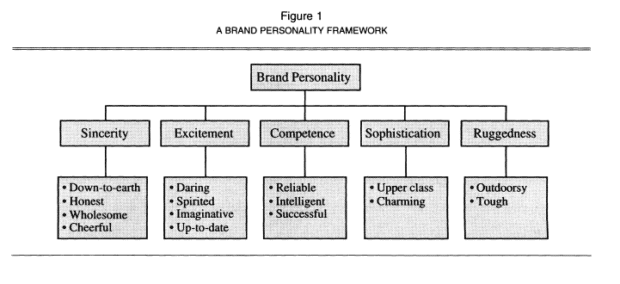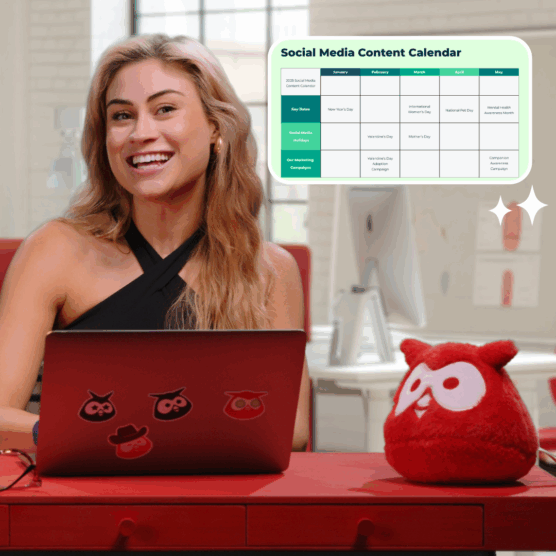Developing a unique, powerful brand voice is the best way to create consistent and compelling content across all channels. Defining your brand voice forces you to think about who you are as a brand and what you really stand for. It also requires you to think about your audience and what matters most to them.
Keep reading to find out how to define your unique brand voice and incorporate it into your social media strategy.
What is a brand voice?
Brand voice refers to the way a brand portrays itself through words. It’s the linguistic version of a brand’s personality. A well-defined brand voice ensures consistency in your marketing communications, helps build a relationship with your customers, and even protects your business from social media missteps.
The definition of your brand voice should start broad and then get very detailed. The broad strokes define your overall tone – such as formal, friendly, jokey, or serious. At the fine details level you might want to include specific words or phrases that should or shouldn’t be used in your brand communications.
We’ll walk you through all the steps of creating a brand voice later in this post. For now, start thinking about your brand and what you want it to represent.
Why is having a consistent brand voice important?
Why exactly does a brand voice matter? It has multiple benefits, from brand awareness to team cohesion.
Make your brand more recognizable
Just like a great brand aesthetic (a.k.a. visual identity), a solid social media brand voice makes your brand more recognizable. When people see your social media posts, they know they’re your social media posts.
In addition to creating a personality for your brand and developing an ongoing relationship with your social followers, this can actually help protect your brand from being impersonated by fake social media accounts.
When your social posts look and feel consistently like you, it’s harder for imposters to get in your way.
Give all teams a communications blueprint
Multiple teams throughout your organization create public-facing content and documents. Think about all the words produced in print or video or audio. This might include:
- Sales
- Marketing
- Customer service
- Public relations
- Investor relations
- Tech support
- Product documentation
While the tone might vary somewhat depending on the context, the overall language and voice should remain consistent at their core.
This is especially useful when you bring in new staff, as they can get up to speed quickly and understand how best to communicate on behalf of your brand.
A brand voice document is also incredibly helpful for anyone external who communicates on behalf of your brand, like freelancers, agencies, and content creators.
As a freelancer, I’ve written for organizations ranging from motorcycle brands to municipal governments. It’s much easier to create content that sounds “right” for the brand in the first draft if they provide me with a brand voice document.
Connect better with customers and prospects
A well-defined brand voice makes your company seem more human. And a more human brand is easier for customers, prospects, and social media followers to relate to.
Especially on social media, people don’t want to follow or engage with a random corporate entity. They want to follow and engage with brands that amuse, entertain, inform, and/or align with their values. That’s true when it comes to purchasing, too. A well-defined social media voice ensures your social content resonates with the people you want to connect with most.
Avoid social media missteps
Unless you’re a one-person shop (in which case, we salute you!), you likely have multiple team members working on your social content.
A well-defined social media brand voice keeps those team members on the same page and helps protect your brand from social posts and comments that include inappropriate language or ideas. This is especially true when thinking about how to respond to negative comments on social media.
Guidelines for responding to negative comments and posts should be included in your brand voice documentation.
How to build a compelling brand voice
Now that you know why you need to define your brand voice, let’s look at how to make it happen.
1. Research your audience
Before you can decide how you should speak to your audience, you need to know who your audience is.
We’ve got a whole post on using social media for market research, but the short version is that you need to know what your audience thinks about you, your products, and the competition. You also need to understand where and how they communicate with each other so you can use the right messaging on the channels where they are most likely to be.
2. Define your mission
In the last step, you defined your audience. Now you need to define what you want to do for them.
When it comes to social media brand voice, this one’s a two-parter. First, you need to define the mission statement of your brand. What is your brand all about? What is it that you most want to achieve?
Next, you need to think about how that relates to your social audience. How does your mission work to improve the lives of your social followers? How do you make their lives better, easier, or more entertaining?
Working through this discussion will help you clarify the overarching message you want to convey to your audience, which in turn will help you understand the language to use when you talk to them.
3. Describe your brand personality
We often talk about creating buyer personas to help you think about your audience as real people. Once you can picture these real people in your mind, it becomes easier to craft social content that speaks to them, rather than trying to speak to everyone.
It’s also helpful to create a brand persona, complete with actual personality traits. What would your brand be like if it were a person? Would it be friendly or aloof? Funny or formal (or both)? Young and hip or established and reserved? Dig into the adjectives to fully round out this brand character.
If you’re not sure where to start, try using the Brand Personality Framework developed by professor Jennifer L. Aaker. The five elements of sincerity, excitement, competence, sophistication, and ruggedness are used by marketing departments around the world to define their brand personalities.
Source: Aaker, J. L. (1997). Dimensions of Brand Personality. Journal of Marketing Research, 34(3), 347–356.
Try to align your brand persona to the personas you defined for your target audience. You don’t have to be the same as your audience, but your brand persona should have attributes your audience personas respect, like, and trust.
4. Put together brand guidelines
Every good brand should have a style guide. Your style guide includes everything about how you present your brand. This includes your brand colors, logos, and – most importantly for this post – your language use guidelines.
You can get really detailed here, even nailing down specific words to use and others to avoid. Be especially detailed about the terms you use to refer to your products, your services, your company, and your employees.
The most important thing is tone. Make sure the tone you describe aligns with the brand personality you defined in the last step.
Include a list of branded hashtags and guidelines for creating new hashtags for future campaigns.
Bonus: Get a free, customizable social media guidelines template to quickly and easily create recommendations for your company and employees.
If you’re managing multiple social media accounts with a team, use a social media management tool like Hootsuite to make sure that your brand voice stays consistent across channels. With Hootsuite, you can set up approvals and easily collaborate on post drafts to always post approved content and keep the quality of your conversations with followers on brand.
Here are a few ways that Hootsuite can help you streamline your workflows:
- Manage all incoming messages and comments from one centralized inbox
- Assign messages to team members as tasks
- Collaborate on post drafts in Hootsuite Planner
- Set posting permissions for individual team members
- Set up easy approvals so the right people have final say
Hootsuite’s approval tools will help you take your social media workflows from “too many cooks” to “teamwork makes the dream work.”
5. Allow for differences between platforms
While your brand personality and the overarching components of your brand voice should be consistent on all channels, you can (and should!) make adjustments to the specifics for each social channel.
It would be weird to go with the same word choices in a blog post, a Tweet, and an Instagram Reel. The language of one just doesn’t make sense for the other. But the Tweet and the Reel should be recognizable as coming from the same brand. Staying true to your brand guidelines will make this easy even as you adjust for platform demographics and trends.
6. Test and tweak
Just like a human personality, your brand voice can evolve over time and shift with new information and learning. As you’re developing a brand voice, keep a close eye on your social analytics. Watch for things that work particularly well, and see if you can spot any language trends that are consistently effective.
At the same time, watch for any unexpected flops. Maybe your audience doesn’t like some of the cute sayings you’ve added to your repertoire? Maybe you went too formal, or too funny, or too casual, and people are feeling a disconnect?
Brand voice can also evolve as social channels evolve. When brands started to join TikTok, they had to figure out a new way of speaking to younger audiences that still aligned with their brand guidelines. Be willing to test, learn, tweak, and test again.
Social media brand voice examples
Liquid Death
Andy Pearson, Liquid Death’s vice-president of creative, has described the brand as “a character we’re writing for.” Thinking of the brand as a persona or character helps keep you true to the brand voice. That comes across in Liquid Death’s social posts across channels.
https://www.instagram.com/p/Cqf-tB9rc9v/?hl=en
Remember that this is a company selling water. Their branding, strongly captured in their brand voice, is one of their primary selling points. Think about how the voice contributes to perceptions of this brand versus SmartWater or Evian. Can you imagine either of those brands telling social audiences to #murderyourthirst?
On that note, let’s look at another water brand…
La Croix
In a complete 180 from the dark tones of Liquid Death, La Croix is all bubblegum colors with a voice to match. Terms like BFF and Bestie appear often in their captions, along with lots of emojis, exclamation points, and puns.
https://www.instagram.com/p/CshCRL7ujka/
https://www.instagram.com/p/CsRKPmHP_Co/
https://www.instagram.com/p/CsHKNfosN7Q/
Thinking about these brands as people, you might imagine that Liquid Death rides a motorcycle, listens to Scandinavian metal bands and wears a leather jacket. Meanwhile, La Croix rides a fixie bike with streamers on the handles, dances to the latest bops and has a closet full of pastels and neon.
Using Aaker’s brand personality framework, Liquid death is daring and tough, while La Croix is cheerful and charming.
Each brand has a voice that aligns with its character, making it easier for customers to relate to the brands and develop a sense of brand awareness and loyalty.
Calm
Take a look at Calm’s Instagram posts, and a couple of things stand out immediately.
- Their captions are on the whole significantly longer than most brands.
- They use infographics and bullet points to convey a lot of information without creating an overwhelming block of text.
https://www.instagram.com/p/CsqzOUstAQH/
https://www.instagram.com/p/CslqZtduGT9/
Once you look a little closer, you’ll see that the tone of voice and messaging are consistent, too. The posts sound like they come from a mashup of your concerned older sister and an inspirational poster.
For comparison, let’s look at another brand in the mental wellness app category.
Headspace
There’s a striking visual difference between Calm’s posts and those shared by Headspace. While Calm uses muted blues, Headspace is full of color. You’d never mistake one for the other, even though the apps operate in the same general market.
Taking a look at the voice of each brand, clear distinctions emerge, too. Both are encouraging and inspirational, but the unique voices aligns with the different visual styles. Headspace is shorter and more direct, with more emojis. The tone is a little more casual and familiar.
https://www.instagram.com/p/Cslig7eMiL1/
Whole Foods
Whole Foods keeps their captions short to let the visuals in their social posts do most of the heavy lifting. They’re often just three or four words and a couple of emojis.
That said, the few words in the captions manage to convey Whole Foods’ brand voice and tone effectively. It’s light. It’s friendly. It’s casual but nice.
https://www.instagram.com/p/CsrnjesJlM7
https://www.instagram.com/p/CscFCtBJtt6/
Trader Joe’s
Trader Joe’s uses much longer captions, divided into sections with line breaks and icons. They speak directly to the audience, using the word “you” a lot. They’re very slightly cheeky, with the use of alliteration, puns, and exclamation marks.
Whereas Whole Foods uses social posts to highlight whole product categories, Trader Joe’s narrows the focus to individual products and the details behind them.
https://www.instagram.com/p/CsR8RnrJuhl/
https://www.instagram.com/p/CsFEffwPk54/
Easily manage all your company’s social media profiles using Hootsuite. From a single dashboard, you can schedule and publish posts, engage your followers, monitor relevant conversations, measure results, manage your ads, and much more.









